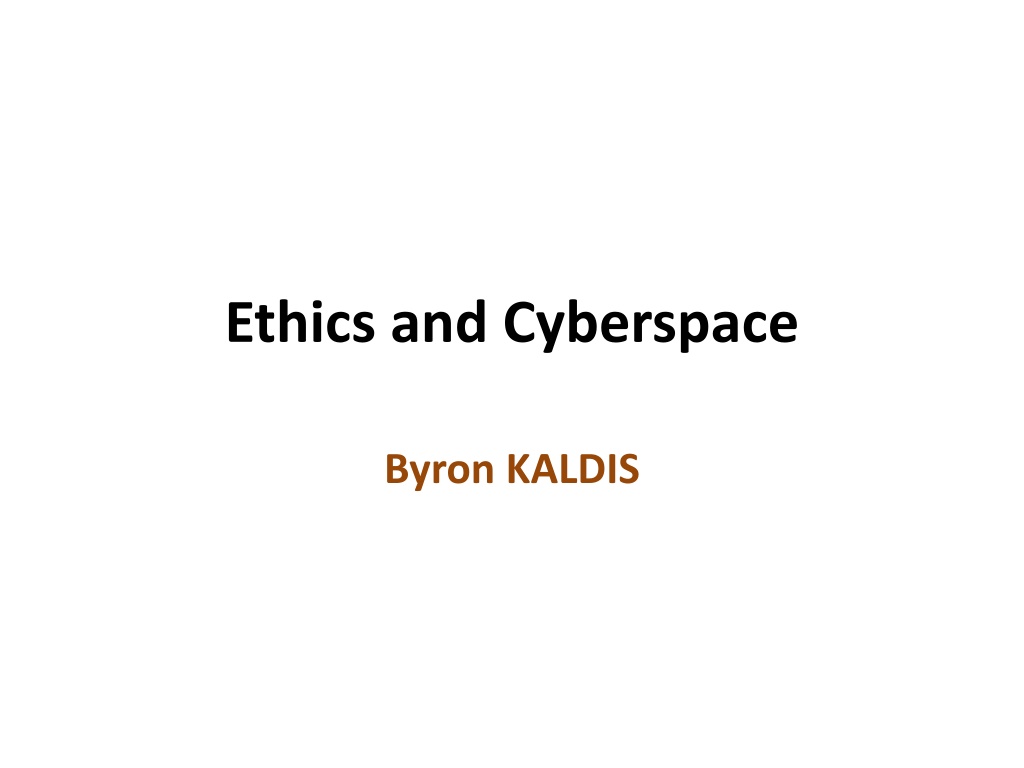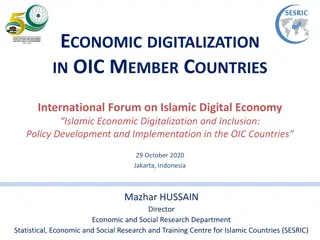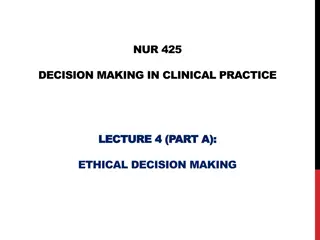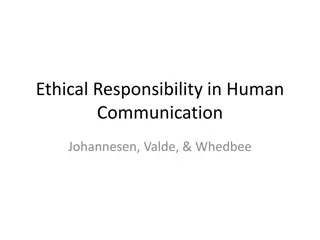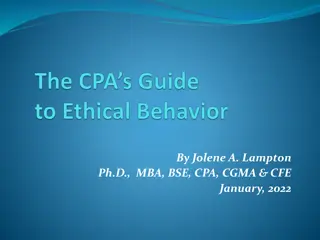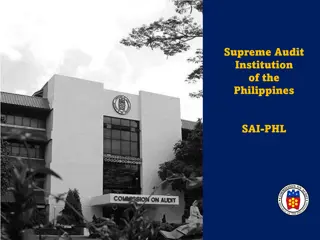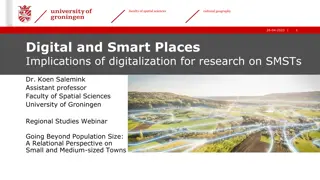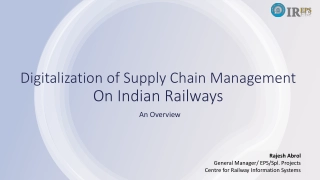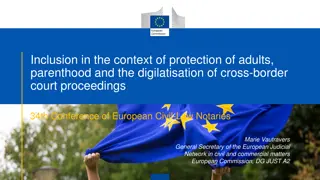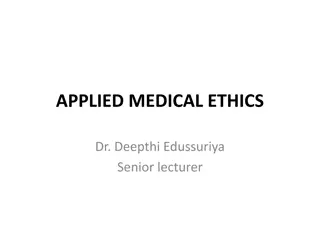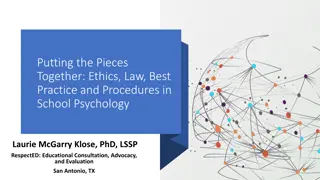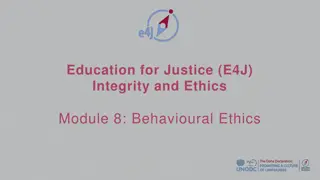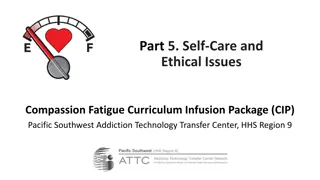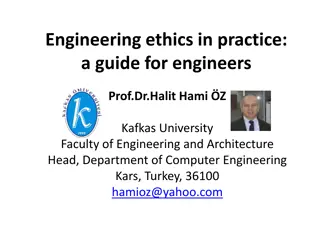Ethical Implications of Digitalization and Information Technology
Exploring ethics and privacy concerns in cyberspace, this content delves into the impact of digitalization and information technology on society. It discusses ethical issues in computer science, the digital divide, social implications in computing, and the importance of human input in leveraging ICT effectively. Privacy risks, security challenges, and the need to address internet crime are highlighted, alongside the opportunities and challenges brought about by high digitalization and technological advancements.
Download Presentation

Please find below an Image/Link to download the presentation.
The content on the website is provided AS IS for your information and personal use only. It may not be sold, licensed, or shared on other websites without obtaining consent from the author. Download presentation by click this link. If you encounter any issues during the download, it is possible that the publisher has removed the file from their server.
E N D
Presentation Transcript
Ethics and Cyberspace Byron KALDIS
Ethical Issues in Computer Science and Information Technology Lecture 1
Information Knowledge as Information: Very important New Technology transmits information in vast amounts and very rapidly and (mostly) freely Information Revolution (4th revolution) Information Age Information Societies
Social Issues in Computing and Information Technology Digital Divide Access Geography Income Ethnicity Age Education
What human input should be: Creating awareness of the potential for ICT to meet one s needs Creating, developing, and strengthening capacity to use information and ICT effectively, using local inputs Building capacity to produce and package information so that it adds value to local inputs Ensuring ongoing technical capacity development and developing a format for sharing knowledge and information Preventing the local capacity from being drained to other, usually developed countries
Ethics and Privacy Important Dangers Internet Criminals Our personal identity Our country s security Security before the internet crime is commited
Challenges High digitalization of information and increasing bandwidth Declining costs of digital communication Increased miniaturization of mobile computing devices and other communications equipment Greater public awareness by the news media of the potential abuse of digital communication, especially the Internet
PRIVACY 1. Control of external influences: Solitude : The right to be alone without disturbances Anonymity : The right to have no public personal id entity Intimacy : The right not to be monitored 2. Control of personal information: Reserve : The right to control one s personal information including the methods of dissemination of that information.
Types of Privacy PERSONAL: privacy of personal attributes and facts prevention of anyone or anything that would intrude (either physically or by electronic means) or violate the personal space where those attributes are
INFORMATION Privacy: protection of unauthorized access to information itself Different Types of Information Privacy: Personal information : Most personal information of value includes information on personal lifestyles such as religion, sexual orientation, political affiliations, or personal activities. Financial information : Financial information is important not only to individuals but also to organizations. Financial information is a very valued asset because it gives the organization the autonomy it needs to compete in the marketplace
Information Privacy Medical information : Medical information is very personal and very important to all of us. For personal, employment, and insurance purposes, many people want their medical information to be private. Internet: In this new age, the Internet keeps track of all our activities online.
Institutional Privacy Institutions (e.g. Research Institutes, Universities, Governments, Businesses etc) wish to keep their data (research data or sales or country sensitive data) secret
Value of Privacy Eroded Personal Identity Personal Autonomy Social Relationships
Database Systems Information Information Gathering Privacy Violation & the Law Intrusion Misuse of Information Interception of Information Information Matching
ANONYMITY: enabled by certain computer means Anonymous servers : (a) Full anonymity servers: no identifying information is forwarded in packet headers. (b) Pseudonymous servers: put pseudonym in forwarded packet headers, keeping the real identity behind a pseudonym, but being able to receive and forward all packets sent to the pseudonym to the real server Anonymous users
Anonymity: good and bad society may not be safe if many criminals use anonymity to hide their criminal activities Anonymity may be good for some relationships and the security of some people Anonymity is good when a whistle-blower uses it to check unhealthy activities within a private business. Anonymity is good in National Defence: in cases of national security so that no underground spies can gather information about our country Etc.
SECURITY Why needed: 1. Confidentiality : To prevent unauthorized disclosure of information to third parties. This is important in a number of areas including the disclosure of personal information such as medical, financial, academic, and criminal records. 2. Integrity : To prevent unauthorized modification of files and maintain the status quo. It includes system, information, and personnel integrity. The alteration of information may be caused by a desire for personal gain or a need for revenge. 3. Availability : To prevent unauthorized withholding of information from those who need it when they need it. ------------------------------------------------------------------------------------------------------------ Physical Security the prevention of access to physical facilitates such as computer Systems Information security prevention of access to information by encryption, authentication , and other means.
Security-2 * Physical Security the prevention of access to physical facilitates such as computer Systems * Information Security prevention of access to information by encryption, authentication, and other means. >>Electronic Access Controls Advances in technology: more invasive electronic controls that include card access control systems, firewalls, and the most important type: The Interior of the software may be secured using electronic barriers such as firewalls and passwords _Cryptography encryptions _Authentication: the system collects information about the user checking that the user is genuine
Software and Ethics Software is a set of computer programs comprising a sequence of short commands called instructions that tell the computer what to do. Software is either built into the computer s more permanent memory, called ROM (read-only memory), or loaded on demand in the less permanent but more volatile memory called RAM (random access memory). Software producer (individual or company etc.) creates or develops a set of programs to meet the specifications of a user, if there is a contract, or of a specific task if it is general software Software buyers, or customers buy or get the finished software from the developer/producer in order to satisfy a need, basing their decision on what the producer claims about the product. The buyer may be an individual or a company etc..
Software: ethical issues Standards( set standards - legal protection of buyers) Development & Testing (it does not always work!) Validation & Verification (mathematical methods for tests to show that the software under review is faulty. Tests are random. But as the level of programming gets lower and lower toward machine code, software bugs get harder and harder to detect, and no amount of V&V is able to prevent those bugs from falling appearing. Reliability: cannot be measured by wear and tear/ measures of reliability Security: (security attacks on systems through software holes rather than through hardware, mainly through piracy, deletion, and alteration of programs and data) Safety: (depends on the design and environment in which such software is used. But because of the multitude of such environments, and because software is the result of many people s input and used in different applications, there is no guarantee that it will work in every environment) Quality ============================ RISKS & HAZARDS: RISK ASSESSEMENT
